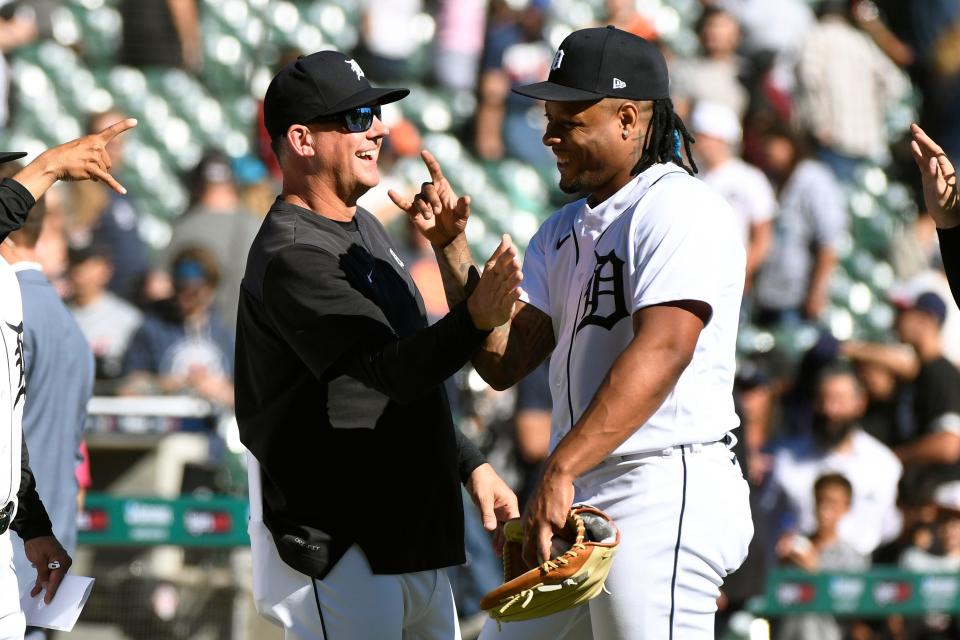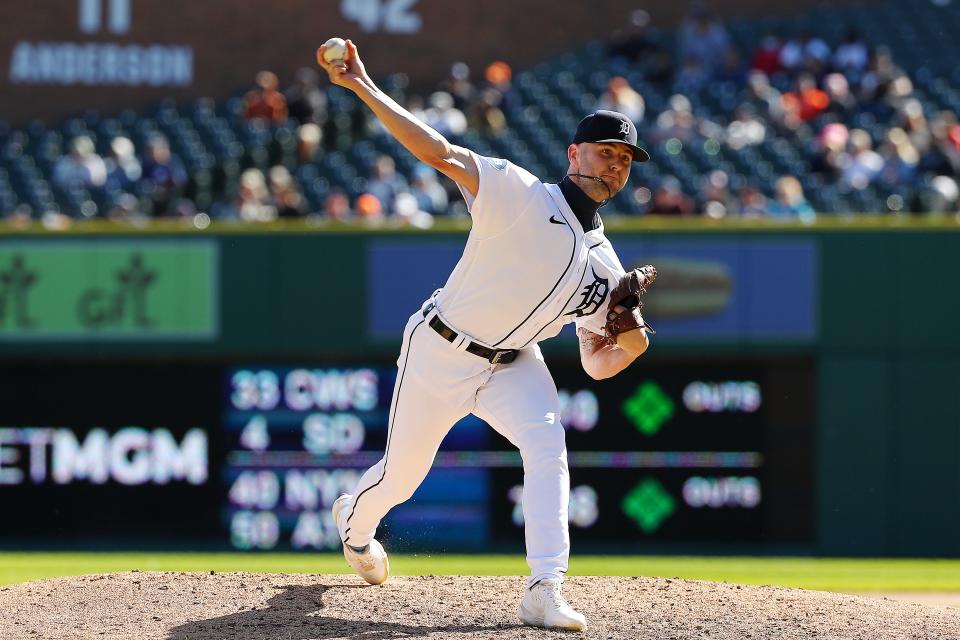What's next for Detroit Tigers' bullpen after trading Gregory Soto? Look to free agency
- Oops!Something went wrong.Please try again later.
- Oops!Something went wrong.Please try again later.
- Oops!Something went wrong.Please try again later.
- Oops!Something went wrong.Please try again later.
- Oops!Something went wrong.Please try again later.
- Oops!Something went wrong.Please try again later.
The Detroit Tigers could have kept Gregory Soto.
Hard-throwing left-handed relievers with multiple years of team control are some of the most valuable pitchers to any organization. Soto fit the profile for the Tigers: He won't become a free agent until after the 2025 season, and his fastball often reaches triple digits. As the Tigers' closer, the two-time All-Star succeeded in more than 92% of save opportunities in the past two seasons.
Still, the Tigers traded Soto (and utility player Kody Clemens) to the Philadelphia Phillies on Saturday in exchange for outfielder Matt Vierling, infielder/outfielder Nick Maton and catcher Donny Sands. In doing so, Tigers president of baseball operations Scott Harris finalized his decision about Soto, opting not to wait until the trade deadline this summer.
"Was that a consideration? Yeah, it was," Harris said. "But we liked this package and felt like it was over the line, and we decided to do it."
UNDERSTANDING THE DEAL: Why Tigers acquired these three position players in trade with Phillies

The Soto situation is fairly simple to understand. He has elite pitch characteristics but has been inconsistent in commanding his arsenal throughout his entire career, averaging 5.4 walks per nine innings over the past two seasons.
His strikeout numbers per inning dropped last season — from 10.7 in 2021 to 9.0 in 2022 — without a grasp for his once-electric slider. As a result, his swing-and-miss rate decreased from an encouraging 31.3% in 2021 to an underwhelming 25.7% in 2022. Those results, combined with an inflated walk rate, might never improve.
If the Tigers thought Soto could recapture his old slider and limit the walks, they probably would have held onto him until the trade deadline.
An improvement there would have skyrocketed his value.
"We've had a lot of conversations about him throughout the winter," Harris said. "We felt like this deal was over the line for us, and we wanted to go ahead and make the deal now. Performance next year, or even in the first half of next year, is never a certainty. That's another risk we would take.
"That's not a commentary on Gregory as a pitcher. It's just a reality of performance in this industry. We felt like, going into the winter, if we could get a deal that was over the line for us, we should be prepared to take it. We're also thrilled that we got players back that have a chance to help us in 2023 and beyond."
THE TRADE: Tigers trade Gregory Soto, Kody Clemens to Phillies for three players
#Tigers president of baseball operations Scott Harris on Matt Vierling, Nick Maton and Donny Sands, acquired from the Philadelphia Phillies: pic.twitter.com/A6kxdGEU9l
— Evan Petzold (@EvanPetzold) January 7, 2023
Harris has completed two significant trades this offseason, dealing Soto for a trio of position players and right-handed reliever Joe Jiménez to the Atlanta Braves at the winter meetings for third baseman/outfielder Justyn-Henry Malloy and left-handed reliever Jake Higginbotham.
The Tigers' bullpen ranked eighth in MLB last season with a 3.43 ERA. Three of the top pitchers from that group — left-hander Andrew Chafin (who exercised an opt-out clause to become a free agent), Soto and Jiménez — aren't on the roster anymore.
But the Tigers are addressing their main weakness from 2022.
"We have to reshape the offense," Harris said. "I've been talking about it since the day I got here. I think this trade is a variant of one of those calculated risks that I've talked about. You're never entirely confident that young players are going to hit in the big leagues, but you're a little more confident when you've seen flashes of them performing in the big leagues already."
What happens next?
After trading Soto, the Tigers don't have an established closer.
Right-hander Alex Lange is the best internal candidate, considering his elite whiff rates on his secondary pitches, but the Tigers won't put labels on their relievers until spring training in February. When Opening Day rolls around, there still might not be a pitcher tagged with the closer role.
"I don't think we're in a position to make any decisions on that front," Harris said. "There's still a lot of offseason left. We also want to see how all of our pitchers perform when they get to camp in Lakeland."
NEW INFIELDER: What Tyler Nevin, 2015 first-round pick, brings to Tigers: 'I have a lot to prove'

Two other high-leverage relievers — right-handers José Cisnero and Jason Foley — could land the closer role. The Tigers, though, lack left-handed pitchers in the bullpen, with long reliever Tyler Alexander as the only lefty reliever seemingly guaranteed to crack the Opening Day roster.
The Tigers have shifted their focus to adding a left-handed reliever in free agency. The best-available pitchers include Chafin, Brad Hand, Matt Moore and Will Smith with lower-tier pitchers such as Daniel Norris and Alex Young still hoping to avoid minor-league contracts. (Moore and Norris are former Tigers.)
"We're hard at work on that," Harris said. "We've actually been working on that this week, and we're hopeful that we can add someone to our mix soon. It may not be a major-league deal, but it may be someone that we're excited about that we're going to bring into camp."
So far, the Tigers have spent $18.5 million this offseason on one-year deals for two starting pitchers: left-hander Matthew Boyd ($10 million) and right-hander Michael Lorenzen ($8.5 million). They have scraped more than $5 million of their projected payroll by trading Soto and Jiménez, as both relievers are arbitration eligible.
The estimated 2023 payroll, according to Fangraphs, is $121 million, with $32 million tied up in the final season of Miguel Cabrera's contract. In theory, the Tigers have the resources to be active on what's left of the free-agent market before spring training begins.
Reliever signs minor-league contract
The Tigers signed right-handed reliever Aneurys Zabala to a minor-league contract in late December. He pitched 2⅔ scoreless innings for the Miami Marlins last season with one walk and two strikeouts.
His fastball averaged just over 99 mph last season against 11 batters faced, but he lacks command.
Before making his MLB debut, Zabala bounced around the minor leagues with the Seattle Mariners (2014-16), Los Angeles Dodgers (2017-18), Cincinnati Reds (2018-19), Philadelphia Phillies (2021) and Marlins (2022).
The 26-year-old has a 5.71 ERA with 192 walks and 294 strikeouts in 304 innings (191 games) across his eight-year career in the minors.
Contact Evan Petzold at epetzold@freepress.com or follow him on Twitter @EvanPetzold.
This article originally appeared on Detroit Free Press: What's next for Detroit Tigers' bullpen after trading Gregory Soto?

